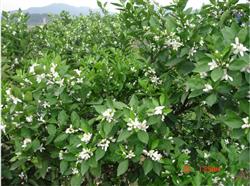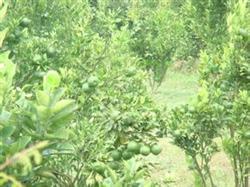Key points of citrus cultivation in April
During the spring shoot emergence period of April (Qingming Festival ~ Grain Rain), the flower bud stage and flowering stage were more overcast and rainy than sunshine in late March, especially in the early ten-day period, and the temperature was on the low side, which affected the spring shoot emergence of citrus. According to the weather forecast, the rainfall in the first ten days of April is less than that of normal years, and the average temperature is higher than that of normal years. There are too many Rain Water in the citrus orchard in spring, the temperature and humidity are suitable, the diseases and pests are easy to breed, and it is also easy to cause abnormal falling flowers and buds, which is one of the key periods of citrus production this year. The following work should be done: (1) the fertile soil is overcast and rainy in late March. it is necessary to clean and dredge the drainage ditch around the orange orchard, do a good job of drainage and soil conservation, and ensure the normal flowering and fruiting of the plant. For the adult trees with weak tree potential and large amount of flowers, it is appropriate to apply bud fertilizer to promote the ripening of new shoots and shoots. Compound fertilizer 0.2-0.3 kg or rarefied human feces 10-20 kg can be applied. For young trees, it is necessary to continue to apply urea, human fecal urine and other quick-acting fertilizers every month to promote shoot growth. Generally, 0.1kg urea is applied to each plant or 5kg to 10kg of rarefied human feces. Grass cultivation can be considered in adult orchards without intercropping, that is, benign weeds are selected in the orchard, which not only saves labor but also has the effect of soil and water conservation, but also can increase the organic matter in the soil and improve the ecological environment of the orchard, such as Huoxiang thistle, white clover, Ziyunying and soybean. spring green manure turns green from late April to late May. The fresh grass cut every year and the regeneration of grass roots can increase soil organic matter, activate soil and improve the vitality of citrus root group year by year. (2) for orange trees with more buds (flowers) and late harvest last year, there are more plants with less flowers. when the spring shoots grow to 2cm or 4cm, they should be strong and weak, and part of the spring shoots should be thinned according to "three thinning one" and "five thinning two", which is helpful to protect flowers and reduce buds and flowers; if the number of flowers is large and the tree is weak, part of the buds or branches should be removed properly. For varieties with serious fruit drop or low fruit setting rate, such as navel orange and local early honey orange, boron-based leaf fertilizer is sprayed at the early flowering stage (not to be used year after year). Spray 50 × 10 ~ 6 gibberellin at 3 / 4 (Yuhuan pomelo should be reduced to 25 × 10 ~ 6) to protect flowers and fruits. Applying foliar fertilizer during the flowering period, 0.3% urea plus 0.2% potassium dihydrogen phosphate or other fruit tree nutrient solution for crown spraying can effectively reduce fruit drop after flowering. (3) the citrus orchards with more flower bud maggots can be covered with plastic film before the adults are unearthed to prevent the adults from climbing the tree. when the calyx begins to crack and show white, the citrus orchards can also be killed with 50% phoxim 150 kg 200 g mixed fine soil 15 kg per mu. Scab is prevented and treated with Bordeaux liquid in 2 / 3 flowers. Spraying is needed when the incidence of autumn shoot leaves is more than 5% last year, when spring shoots are 0.2 to 0.3 cm long and when flowers are shedding 2 / 3 cm. If the incidence rate is less than 5%, mainly catch flower Xie 2 / 3 spray. Huaxie 2 / 3 can choose 78% Cobo wettable powder 600 times liquid, 80% essential wettable powder 500 times liquid, 77% copper hydroxide wettable powder 600 times liquid, 0.5% equivalent Bordeaux solution or 70% methyl topiramate wettable powder 800 times liquid, etc. Sweet oranges and other varieties sensitive to canker should be treated with Bordeaux solution and other agents about 10 days after flower shedding, and prevent scab, black spot, resin disease, anthrax and so on. When there are fresh insect droppings of longicorn beetle larvae, kill them with steel wire hooks. Before the adult begins to lay eggs (from late March to early April), the branches within 1 meter from the ground should be wrapped or whitened with woven bags to prevent spawning. Citrus orchards with more scale, mites and soot disease. The reproduction of citrus red spiders is accelerated with the increase of temperature. When the number of spiders per leaf reaches more than 3 to 4, we should choose Baumei 0.3: 0.5 stone sulfur mixture, 5% thiazide (nisolone) 1500 times, 15% dacaron 1200 × 2000 times, 20% tetraacarazine 1500 × 2000 times, and so on.
- Prev

A New method of protecting Flowers and fruits of Citrus without hormone
Citrus flower and fruit protection is one of the important measures for high quality, high yield and stable yield cultivation of citrus, especially for citrus suffering from light freezing in winter, flower and fruit protection is more important. In view of the fact that spraying "920" and 2mai 4rel D can easily cause abnormal fruit, pollute the fruit and affect the quality of citrus, here are several kinds of plants without hormones and plants.
- Next

Key points of citrus cultivation in March
March (sting-the Spring Equinox) spring shoot sprouting and shooting period-entering March, the climate gradually warms up, and new shoots begin to sprout. All kinds of overwintering diseases and insects will begin to do harm one after another.
Related
- Moge, come on! The staff of the peasant association in the producing area of cantaloupe were frightened when the crowd gathered.
- Causes and Solutions of low Fruit setting rate of Apple
- Symptoms and control measures of passion fruit virus disease
- Fruit growing lesson: how do apple orchards keep high yields?
- Can you build orchards in the mountains? What are the pros and cons?
- How to manage the coloring period of Crisson grape?
- This paper introduces the processing technology of two kinds of fig products.
- How much is a month for retired teachers in rural areas by 2020?
- How can strawberry planting increase sugar content? We should pay attention to management in many aspects.
- What are the cultivation techniques on how to improve the yield of golden fruit?

